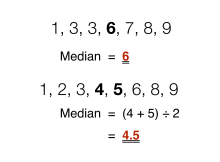The mode of a sample is the element that occurs most often in the collection. For example, the mode of the sample [1, 3, 6, 6, 6, 6, 7, 7, 12, 12, 17] is 6.
The variance of a random variable X is the expected value of the squared deviation from the mean of X:
Var(X) = E[(X - μ)²]
Usually the expected value for most distributions is the arithmetic mean:
Standard deviation is the square root of the variance.
Example: The marks of a class of eight students (that is, a population) are the following eight values:
For example, the marks of a class of eight students (that is, a population) are the following eight values:
These eight data points have the mean (average) of 5:
First, calculate the deviations of each data point from the mean, and square the result of each:
The variance is the mean of these values:
and the population standard deviation is equal to the square root of the variance:
This is used to approximate standard deviation of the population, from a standar deviation of a sample.
Reference: Wikipedia












